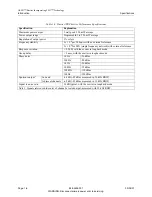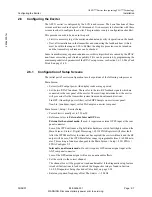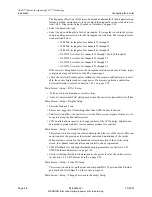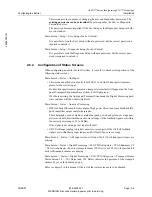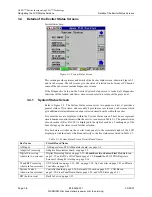
APEX
™
Exciter Incorporating FLO
™
Technology
Configuring the Exciter
Installation
26
04s20
0.fm
03/08/07
888-2604-001
Page: 2-7
WARNING: Disconnect primary power prior to servicing.
2.6
Configuring the Exciter
The APEX exciter is configured by the LCD touch screens. The basic functions of these
screens are discussed in chapter 3 of this manual. It is necessary to be familiar with these
screens in order to configure the exciter. This procedure is only a configuration checklist.
This procedure needs to be done in two parts.
• First it is necessary to get the exciter on channel and verify its operation on the bench.
• Next, after installation in the transmitter and connecting the feedback lines (which
must be within the range of -30 to 0 dBm), the adaptive processor can be turned on
and the transmitter performance can be checked.
Some transmitters may experience nuisance overdrive trips which are caused by the RTAC
non-linear correction peak stretch capability. This can be prevented by programming the
maximum peak stretch parameter of the RTAC setup screen, see Section 3.6.3.2, Max Peak
Stretch, on page 3-40.
2.6.1
Configuration of Setup Screens
The initial part of exciter configuration involves portions of the following setup screens.
Main Screen.
• Set exciter RF output power (the display reads average power).
• Set the two RTAC functions. These refer to the two RF feedback signals which are
connected to the rear panel of the exciter. These settings determine how the exciter
will pre correct for the transmitter system linear and nonlinear distortions.
Lin HPF: (linear high power filter), called HPF Sample on exciter rear panel.
Non-Lin: (nonlinear input), called PA Sample on exciter rear panel.
Main Screen > Setup > Exciter Setup.
• Power Limit is usually set to 250 mW.
• Reference, refers to
External or Internal GPS
use.
External is the normal mode.
If used, it requires an external 1PPS input at the rear
panel connector.
Loss of the 1PPS will cause a Digital Status hardware switch fault (lights red) and the
Main Screen > Status > Digital Processing > FLO FPGA Registers will show fault.
After the 1PPS Mute Delay loss time out has expired, the exciter will mute and the RF
output will be zero. The 1PPS Mute Delay range is programable from 0 to 2000 min-
utes. This setting is found (or changed) in the Main Screen > Setup > FLO FPGA >
FPGA Configure 2/5.
Internal is an alternate mode.
If used, it requires GPS antenna signal input at the
ANT rear panel connector.
Loss of the GPS antenna signal will cause no noticeable effects.
• Set the exciter to the correct channel.
The channel box will be greyed out (and unattainable) if the diagnostic setup feature
is locked. Instructions to lock or unlock the diagnostics setup is found in Section
3.6.8.2, Diagnostics Setup (Locked or Unlocked), on page 3-54.
• Enter any required frequency offset. The limit is +/- 50 kHz.








